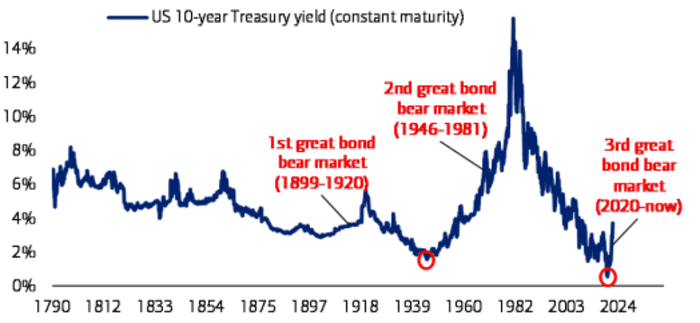This post was originally published on this site
Global government-bond markets are stuck in what BofA Securities strategists are calling one of their greatest bear markets ever — which, in turn, is threatening the ease with which investors will be able to exit from the world’s most-crowded trades, if needed.
Those trades include long positions in the dollar, U.S. technology companies and private equity, said strategists Michael Hartnett, Elyas Galou, and Myung-Jee Jung. Bonds are generally regarded as one of the most liquid asset classes available to investors; once liquidity dries up there, that spells bad news for just about every other form of investment, other analysts said.
Financial markets have yet to price in the worst-case outcomes for inflation, interest rates, and the economy around the world, despite tumbling global equities along with bond selloffs in the U.S. and the U.K. on Friday. Dow industrials
DJIA,
were off by more than 700 points at their lows, flirting with a fall into bear-market territory, while the S&P 500
SPX,
threatened to take out its June closing low.
U.S. yields were trading at multiyear highs. Meanwhile, government-bond rates in the U.K., German, and French have risen at the fastest clip since the 1990s, according to BofA Securities.
“Inflation/rates/recession shocks are not over,” plus the bond crash in recent weeks “means highs in credit spreads, lows in stocks are not yet in,” the BofA strategists wrote in a note released Thursday. They said investor sentiment is “unquestionably” the worst since the 2007-2009 global financial crisis. The strategists also see the fed-funds rate target, Treasury yields, and the U.S. unemployment rate all heading to between 4% and 5% over coming months and quarters.
Government bonds have racked up losses of 20% this year, as of Thursday — the worst losses since 1920, according to BofA. For all of 2022, global government bonds are on course for one of their worst performances since the Treaty of Versailles, which was signed in 1919 and went into effect in 1920 — establishing the terms for peace at the end of World War I. Yields and bond prices move in opposite directions, so rising yields reflect the sinking prices on government debt.

Source: BofA Global Investment Strategy, Bloomberg
Liquidity matters because it ensures that assets can be bought or sold without significantly impacting the price of that security. Without liquidity, it’s harder to convert an asset into cash without losing money against the market price.
Government bonds are the world’s most liquid asset so “if the bond market does not function, then no other market functions, really,” said Ben Emons, managing director of global macro strategy at Medley Global Advisors in New York.
“Rising yields continue to dry up credit and are going to hit the global economy hard,” Emons said via phone on Friday. “There’s a risk of a ‘sell-everything market’ that would resemble March 2020, as people withdraw from markets amid greater volatility and find they cannot actually trade.”
A historic bond selloff in the U.K. on Friday, triggered by eroding investor confidence fueled by the government’s mini-budget plan, only exacerbated fears about worsening liquidity, particularly in the ordinarily safe Treasury market.
Read: The next financial crisis may already be brewing — but not where investors might expect
In the U.S., Federal Reserve officials have shown a willingness to break something with higher rates —whether it be in financial markets or the economy — to bring down the hottest inflation spell of the past 40 years.
Part of this month’s retreat in global bond prices “is the real fear that central bank hikes spiral upward in a competitive race to maintain currency viability and not to become the last country holding the bag of runaway inflation,” said Jim Vogel, an executive vice president at FHN Financial in Memphis.


